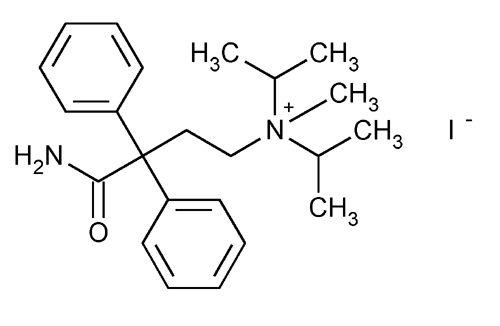Isopropamide Iodide
Benzenepropanaminium,
(3-Carbamoyl-3,3-diphenylpropyl)diisopropylmethylammonium iodide
» Isopropamide Iodide, dried in vacuum at 60 for 2 hours, contains not less than 98.0 percent and not more than 101.0 percent of C23H33IN2O.
for 2 hours, contains not less than 98.0 percent and not more than 101.0 percent of C23H33IN2O.
Packaging and storage—
Preserve in well-closed, light-resistant containers.
Identification—
B:
To 5 mL of a solution (1 in 1000) add 5 mL of sodium carbonate solution (1 in 100), 0.5 mL of bromophenol blue TS, and 10 mL of chloroform, and shake for several minutes: the chloroform layer becomes an intense blue in color.
C:
A solution (1 in 1000) responds to the tests for Iodide  191
191 .
.
Loss on drying  731
731 —
Dry it in vacuum at 60
—
Dry it in vacuum at 60 for 2 hours: it loses not more than 1.0% of its weight.
for 2 hours: it loses not more than 1.0% of its weight.
Residue on ignition  281
281 :
not more than 0.5%, after ignition at 550 ± 25
:
not more than 0.5%, after ignition at 550 ± 25 for 4 hours.
for 4 hours.
Heavy metals, Method II  231
231 :
0.002%.
:
0.002%.
Ordinary impurities  466
466 —
—
Test solution:
methanol.
Standard solution:
methanol.
Eluant:
a mixture of methanol, glacial acetic acid, and water (8:1:1).
Visualization:
2.
Assay—
Dissolve about 750 mg of Isopropamide Iodide, previously dried and accurately weighed, in 60 mL of glacial acetic acid, add 15 mL of mercuric acetate TS and crystal violet TS, and titrate with 0.1 N perchloric acid VS to a blue endpoint. Perform a blank determination, and make any necessary correction. Each mL of 0.1 N perchloric acid is equivalent to 48.04 mg of C23H33IN2O.
Auxiliary Information—
Please check for your question in the FAQs before contacting USP.
Chromatographic Column—
| Topic/Question | Contact | Expert Committee |
| Monograph | Elena Gonikberg, Ph.D.
Senior Scientist 1-301-816-8251 |
(MDGRE05) Monograph Development-Gastrointestinal Renal and Endocrine |
| Reference Standards | Lili Wang, Technical Services Scientist 1-301-816-8129 RSTech@usp.org |
USP32–NF27 Page 2702
Chromatographic columns text is not derived from, and not part of, USP 32 or NF 27.
